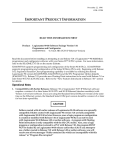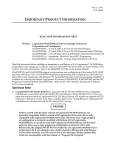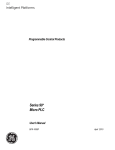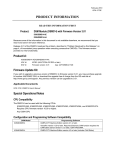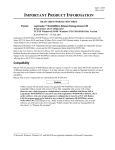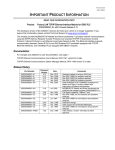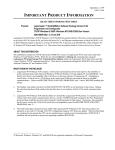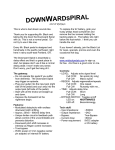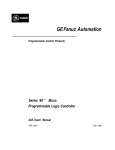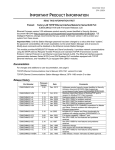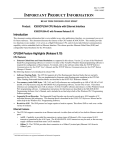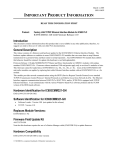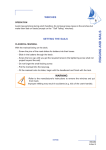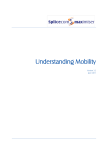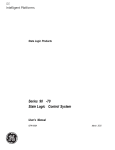Download IPI, Logicmaster 90-30 Software Package Version 6.50
Transcript
March 22, 1996 GFK-1323 IMPORTANT PRODUCT INFORMATION READ THIS INFORMATION FIRST Product: Logicmaster 90-30 Software Package Version 6.50 Programmer and Configurator IC641SWP313A –3.5-inch HD (TCP/IP Ethernet Version) Read this document before installing or attempting to use Release 6.50 of Logicmaster 90-30/20/Micro programmer and configurator software with your Series 90 30 PLC system. For more information, refer to the README.TXT file on the master diskette. IC641SWP313 supports programming and configuration of the Series 90-30 PLCs. IC641SWP300 supports programming and configuration of the Series 90 Micro PLCs only. Beginning with Release 5.01, Sequential Function Chart programming capability is available by ordering the desired Logicmaster 90 version (IC641SWP306, IC641SWP313) and the SFC Programmer Option diskette (IC641SWP311). Release 6.50 provides several new features. Refer to the “New Features Introduced in Release 6.50” section for details. Operational Notes 1. Compatibility with Earlier Releases: Release 6.50 of Logicmaster TCP/IP Ethernet software requires a version 6.5 or later Series 90-30 CPU and 90-30 Ethernet Interface module(s) with Version 1.10 or later software. If you are using the Standard Serial COM port version at the same time as the Ethernet version, the Standard Serial COM port version should be version 6.5 or later for best inter-operability. CAUTION Folders created with all earlier releases of Logicmaster 90-30 software are upwardly compatible. Folders created with Logicmaster 90 version 6.50 are fully compatible with Logicmaster 90-30 3.50 or later. However, once a logic program or configuration is created or modified with Release 6.50 of Logicmaster 90-30, it can not be used with Logicmaster 90-30 Release 3.02 or earlier software. Also, once a logic program or configuration is stored to a PLC with Release 6.50, the program MUST NOT be loaded by an Logicmaster 90-30 release earlier than 3.50. If you attempt to use a folder created in Release 6.50 with Release 3.02 or earlier software, you will receive one of two messages “Folder contains files which are incompatible with this release” or “Program file corrupted.” 2. System Requirements: S The Logicmaster 90-30 Ethernet version requires either a minimum of 600 KB (577,536 bytes) of available DOS application memory in order to run. Some folders may require more. 2 Important Product Information GFK-1323 S It also requires a minimum of 1024 KB of Lotus/Intel/Microsoft Expanded Memory (LIM EMS 3.2 or higher) for optimum performance. S Some folders may require additional memory. If additional DOS application memory is required, system software error ID: 0000 EX: 0000 will occur. Check the AUTOEXEC.BAT and CONFIG.SYS files to remove any device drivers and Terminate and Stay Resident (TSR) programs to make more application memory available. For example, Logicmaster does not require the ANSI.SYS driver. S The Logicmaster 90-30 and Beame and WhitesidetTCP/IPEthernet software will occupy about 8.5 MB of disk space. Please make sure you have adequate space on your disk before attempting to install the software. S DOS Version 5.0 or later. S 80386 or higher computer. S For the Standard Serial COM Port version, a computer with a serial COM Port serviced by the National Semiconductor 16550 UART is recommended. 3. Logicmaster 90 Installation For detailed instructions on installing the Logicmaster 90-30 Ethernet software, refer to Chapter 2, “Installing and Starting Up the Software,” of the Logicmaster 90-30 and Logicmaster 90-70 TCP/IPUser’s Manual Supplement (GFK-1029B). Remember that Logicmaster 90-30/20/Micro software is licensed to run on a single computer. If you are installing Logicmaster for the first time, you must enter the serial number found on the back of your disks (unless you have the upgrade version). The INSTALL disks are copy protected. Since backup copies of these disks cannot be made, they should be used to install the software and then stored in a safe place. If your PC uses the 386MAXt memory manager, it may be necessary to manually add the following line to your AUTOEXEC.BAT file and then to reboot the PC before executing LM90: SET RTVMEXT = 0 Failure to do so may result in fatal error messages or other unpredictable results. NOTE Once the LM90-30 Ethernet TCP/IP version is installed on a disk, you should not attempt to install an earlier release of the Standard Serial COM Port version of LM90-30. The Ethernet and Standard COM Port versions share the same directories, and installing an earlier release would result in the loss of Ethernet functionality. 4. SFC Programmer Installation (IC641SWP311) The Sequential Functional Chart (SFC) Programmer (IC641SWP311) diskette updates Logicmaster 90 Release 5 or later to provide SFC programming capability. You must install Logicmaster 90 Release 5 or later first. Then install SFC with the SFC Programmer diskette (by typing INSTALL, e.g., a:install). t 386MAX is a trademark of Qualitas. Important Product Information GFK-1323 5. Demo Version (IC641SWP303): The Logicmaster 90-30/20/Micro Demo version will install into the LM90DEMO directory on the hard disk specified during the install. For example, if you specify that the demo version software be installed on the C: drive, it will be installed in the C:\LM90DEMOdirectory. To run the demo software type the following from the DOS prompt: CD \LM90DEMO then press Enter Then type LM90DEMO and press Enter The demo version is fully functional. However, the program size is limited to 750 bytes for the _MAIN block and 750 bytes/program block. 6. Running Logicmaster 90 from a Disk That Does Not Contain the Logicmaster 90 Software: If you need to run Logicmaster 90-30/20/Micro from a disk that does not contain the software, you should setup the $PLCROOT environment variable in your AUTOEXEC.BAT to point to the location of the Logicmaster 90 software: SET $PLCROOT=(drive ID):\LM90 7. LOAD/STORE May Disrupt Other Communication Links: When loading from or storing to the PLC using the LM90-30 TCP/IP version, other communication modules (PCM, CMM, GBC, and Ethernet) may experience delays while communicating to the CPU. In extreme cases where the load or store is very large, a communication error may be returned. In these cases, a retry of the communications should correct the error. 8. Determining If an IP Address Has Already Been Used: To determine if you have configured your station (Logicmaster 90 PC or Series 90-30 TCP/IP Ethernet) with the same IP address as another station, disconnect the station in question from the LAN, then try a PING command to that IP address from another station. If you get an answer to your PING, then the chosen IP address is already in use. (Refer to the next section for instructions on using the Ping command). Testing TCP/IP Software After Installation After installing the programmer and configurator TCP/IP Ethernet software, you should verify that communications can be established. To test the TCP/IP software after installation, do the following: First, PING from the PC to the PLC with the following procedure: 1. Determine the IP address of the PLC Ethernet module. Assume for the purposes of this example that the IP address is 3.16.32.64. 2. From the DOS prompt, enter the following command (use actual IP address): C:\> PING 3.16.32.64 3. The command line display will look something like the following: PING 3.16.32.64 : xx data bytes xx bytes from 3.16.32.64 : icmp_seq=0. time=xxx. ms xx bytes from 3.16.32.64 : icmp_seq=1. time=xxx. ms xx bytes from 3.16.32.64 : icmp_seq=2. time=xxx. ms 3 4 Important Product Information GFK-1323 4. After five or more lines have been displayed, enter Control-C to stop the PING utility. This will display the PING statistics, which will look similar to the following: __________ 3.16.32.63 PING Statistics _______ xx packets transmitted, xx packets received, xx% packet loss roundtrip(ms)min/avg/maxxx/xx/xx 5. A correctly functioning PING command will show a zero percent (0%) packet loss. If the PC-to-PLC PING (described above) works successfully, then PING from the PLC to the PC with the following procedure: 1. Determine the IP address of the PC running the TCP/IP driver. Assume for the purposes of this example that the IP address is 3.16.32.65. 2. To issue the Ping command from the PLC Ethernet module, you must have access to the Ethernet module’s Station Manager which you can do by connecting a terminal emulator or dumb terminal to port #1 of the PLC Ethernet module using the included cable IC693CBL316. For details about the Station Manager, refer to GFK-1186, also included. From the terminal, enter the following station manager commands: 1. Enter the Station Manager login command. This will prompt you for a password. The default password is system. Once logged in, you will be at the Modify level. 2. Enter the Station Manager command “ping 3.16.32.65” (except use the actual PC IP address). This will produce PING statistics that look similar to the following: <<< Ping Results >>> Command: ping 3.16.32.65 1 100 64 Remote IP Address: 3.16.32.65, Sent =1, Received=1, No Response=0 Roundtrip(ms)min/avg/maxxx/xx/xx 3. A correctly functioning PING command will show the number of Sent and Received packets equal and the “No Response” field equal to zero. If the PING from the PC works, but the PING from the PLC does not, check to make sure that the IRQ address in your CONFIG.SYS matches the IRQ assignment shown by the BWCUSTOM utility. 9. Logicmaster 90 Performance: Logicmaster 90 software requires that the CONFIG.SYS file has BUFFERS set to at least 15 (BUFFERS=15). To increase performance, the buffers should be increased. If you have MS-DOS 5.0 (or higher) and load DOS High, you should be able to set buffers up to 48. This will help the performance of program searches, program loads, program stores, and other disk operations. Beginning with Release 3.50 of Logicmaster 90-30/20 software, the variable tables that once were in memory have been moved to disk. While up to 5000 nicknames are now allowed in the _MAIN variable declaration table, the performance of Logicmaster 90 software may be affected. For best performance, Lotus/Intel/Microsoft Expanded Memory (EMM) version 3.2 or higher of at least 1024 KB and SMARTDRV should be provided. A memory manager is required for the Standard Serial COM Port version of the Logicmaster 90 software. A memory manager is provided with MS-DOS 5.0 (or higher) for a 386 or higher computer. However, some computers or PC configurations will require a memory manager such Important Product Information 5 GFK-1323 t t t as 386MAX , QEMM-386 , or QRAM , produced by Qualitas and Quarterdeck, respectively, to provide the maximum amount of memory for Logicmaster 90 and other applications. The Logicmaster 90-30 and Logicmaster 90-70 TCP/IP-Ethernet User’s Manual Supplement (GFK-1029B) will assist you in setting up your computer system to run the Logicmaster 90-30 software optimally. 10. Using MS-DOS to Copy Folder Files: MS-DOS should not be used to copy individual files from one folder to another or to delete files; doing so may result in corrupted folders. MS-DOS may only be safely used to copy an entire program folder to another program folder of the same name. For most copying needs, however, use the Copy function within the Logicmaster 90-30/20/Microsoftware. 11. Serial Printing: The serial ports, COM1 and COM2, can be used for serial printers. Beginning with Release 4.50, the serial printer port must be configured with the MS-DOS mode command to match the printer settings. Refer to Logicmaster 90-30/20/Micro Programming Software User’s Manual, GFK-0466G, chapter 6, section 6, “Serial Print Setup” for details. 12. PLC Communication Options: If more than one communications option (WSI, Standard Serial COM Port, SLIP, Ethernet) of Logicmaster are installed on the same hard disk, it will be necessary to select which version you wish to run. Refer to Logicmaster 90 Series 90 -30/20/Micro Programming Software User’s Guide (GFK-0466G), the “PLC Communications Options” section of Appendix C, “Programmer Environment Setup,” for details. t t 386MAX is a trademark of Qualitas. t QEMM-386 and QRAM are trademarks of Quarterdeck Office Systems. t 6 Important Product Information GFK-1323 New Features Introduced in Release 6.50 1. Logicmaster Connection to PLC via Ethernet: You can now connect Logicmaster 90-30 to your 90-30 PLCs directly via your in-plant Ethernet network. 2. Logicmaster 90-30 SLIP Communications: The SLIP Communication choice on Logicmaster 90-30 allows a Logicmaster to communicate to Series 90-30s on an Ethernet Network via a dial-up phone line. A SLIP server (Router) is needed on the Ethernet network and a modem is needed on the Logicmaster end. Refer to the Logicmaster 90-30 and Logicmaster 90-70 TCP/IP-Ethernet User’s Manual Supplement (GFK-1029B) for further details. 3. LIMITED Mode for Communications Window: LIMITED mode can now be set for the Communications Window from the PLC Sweep screen. LIMITED mode is supported by Release 6.5 or later Series 90-30 CPUs (except for the Micro CPUs). Important Product Information 7 GFK-1323 Using Release 6 Logicmaster 90-30 with Earlier Versions of Series 90-30/20/Micro CPUs Logicmaster 90-30/20/Micro Release 6.50 was designed and tested to be compatible with Release 6 or earlier 90-30, 90-20, or Release 1 Series 90 Micro CPUs while still providing new Logicmaster features. However, some new features found in Release 6.50 Logicmaster 90-30/20/Micro require an upgrade of CPU firmware to be fully available. SFC PROGRAMMING Programs that use SFC (Sequential Function Chart) programming require CPU release 5.0 or later. SFC is not supported by the Series 90-20 or Series 90 Micro PLCs. SUBROUTINES Subroutines require a 90-30 CPU. They are not supported by the Series 90-20 or the Series 90 Micro PLC. PERIODICSUBROUTINES Periodic Subroutines require a Release 4.20 (or later) 340 or higher CPU. If a program contains a periodic subroutine, it cannot be stored to a Series 90-30 341 CPU earlier than Release 4.20. Note Only Models 340 or higher Series 90-30 PLCs support use of a periodic subroutine at this time. Only periodic subroutine names of the form 1Tnn are supported at this time (nn is a number from 1 to 10 which specifies the number of milliseconds between executions of the subroutine). Only one such subroutine is allowed. NEW INSTRUCTIONS The following instructions require a Release 4.50 or later 90-30 or 90-20 CPU, or a Release 1 or later Series 90 Micro CPU. MASKED COMPARE OFF DELAY TIMER 1 MS TIMEBASE FOR TIMERS Use of the above instructions with a CPU that does not support the instruction will result in one of the following messages when attempting to store to program to the PLC: “Store aborted; Program in folder uses instructions not supported by PLC” or “Program size too large for PLC or invalid user program.” 8 Important Product Information GFK-1323 Problems Resolved by Release 6.50 1. Micro Field Processor %R Limits: Logicmaster 90 would not allow more than 256 %R references to be programmed for the Micro Field Processor. This problem has been corrected to allow up to 2048 %R references to be programmed. 2. Micro Field Processor and Overrides: For the Micro Field Processor, bit memory types (e.g., %I and %Q), contacts, and coils would sometimes flash as if they were overridden even though overrides are not supported. This problem has been corrected. 3. 28 Point Micro %AQ Limits: Logicmaster 90 would not allow more than 64 %AQ references to be programmed for the 28 Point Micro (IC693UAA007). This problem has been corrected to allow up to 128 %AQ references to be programmed. 4. SFC Steps with Comments Only: If a step exists with comments only (no logic), the PLC would execute this step and the next one as well. This problem has been corrected. Restrictions and Open Problems 1. Display of Ladder Rung with > 64 Boolean Elements: Logicmaster 90-30 TCP/IP Ethernet will not properly display the states of the boolean elements (e.g., contacts and coils) for a rung that contains greater than 62 boolean elements. 2. Logicmaster 90 TCP/IP Lockup: Logicmaster 90-30 TCP/IP Ethernet requires a version 6.50 or later CPU for correct operation. If you attempt to use Logicmaster 90-30 TCP/IP with a version CPU earlier than 6.50, it may lock up on startup of the Programming or Configuration software. 3. 28 Point Micro and Program Memory: Logicmaster 90-30/20/Micro does not allow more than 6 kilobytes to be programmed for the 28 point Micro PLC (IC693UDR005). You can program up to 12 kilobytes if you temporarily configure another Micro PLC such as the Micro Field Processor or 28 point Micro PLC (IC693UAA007). After you have finished entering the logic program, you may change the configuration back to the 28 point Micro PLC (IC693UDR005). 4. Variable Import Using CSV File Containing an SFC Name: If you attempt to import variables using an SNF CSV file that contains a reserved SFC name (e.g., S1), the import terminates without an error message. 5. Import of a Variable with % in the Name: The variable import process may terminate if a variable is encountered with a % in the nickname (e.g., ZSTP%OL). 6. Variable Reference Description Quotation Marks Stripped: If you attempt to import a description (e.g., Servo Value “ON” Slow) with quotation marks, the quotation marks are stripped (e.g., Servo Value ON Slow). 7. Logicmaster 90 Install Using DOS 6.0 or Later: MS-DOS 6.0 or later supports multiple configurations in the same file. However, during an Logicmaster 90 installation changes in the CONFIG.SYS and AUTOEXEC.BAT files are only made to the first section for files, buffers, and the Logicmaster 90 path. 8. Passwords Enable/Disable: Attempting to store a configuration that enables passwords to a PLC with passwords disabled will result in the configuration in the PLC being cleared. 9. Search Ref Descriptions: If a program contains references that have the same reference description text, attempting to search for the reference description will always result in the first occurrence of the reference description being found. 10. Rung Limit: The maximum number of rungs allowed in the 90-30/20/Micro _MAIN block is 3000 and in each subroutine is 3000. Important Product Information 9 GFK-1323 11. Store > 32 KB Program, Registers, etc., to CPU341 (or CPU340) EEPROM: The maximum size of an EEPROM for the Series 90-30 is 32 KB. An attempt should not be made to store more than 32 KB to an EEPROM; if the combined total of program, registers, etc., is greater than 32 KB and you try to store it to an EEPROM, Logicmaster 90 will lock up. 12. SFC Search: If an SFC Topology is invalid and a source and destination connector exist with the same name, the destination connector will not be found by search if the destination connector appears below the source connector. 13. Micro PLC and Checksum Words: Logicmaster 90 allows the Chksum Wrds per PLC sweep to be configured for the Series 90 Micro PLC. However, the Series 90 Micro PLC does not support this configuration parameter. 14. ADC Module Supported in Main Rack Only: The ADC module is supported in the main rack (rack 0) only; however, Logicmaster 90 will allow the ADC module to be configured in any rack. Corrections to the Series 90 Manuals On page 4-47 of the Series 90-30/20/Micro Programmable Controllers Reference Manual (GFK-0467G), the description in the fourth paragraph is more accurately stated as follows: If the number of bits to be shifted (N) is greater than the number of bits in the array (LEN) * 16, or if the number of bits to be shifted is zero, then the array (Q) is filled with copies of the input bit (B1) and the input bit is copied to the output power flow (B2). On page 4-63 of the Series 90-30/20/Micro Programmable Controllers Reference Manual (GFK-0467G), the text for Example 1 of the Move function states that, “Even though the destination overlaps the source for 16 bits, the move is done correctly.” This is true for all CPUs except the 351 model. For increased performance on the 351 PLC, the Move function block does not support overlapping IN and Q parameters. If your programming needs require overlapping IN and Q parameters in a 351, then use the Array Move function block with the indices set to 0 and N=LEN. The following note needs to be added in pages 4-125–4-133 (the pages discussing the PID function) of the Series 90-30/20/Micro Programmable Controllers Reference Manual (GFK-0467G): NOTE A particular PID function call should not be made more than once in a sweep. The above changes will be made in the next revision of the Series 90 manuals.









